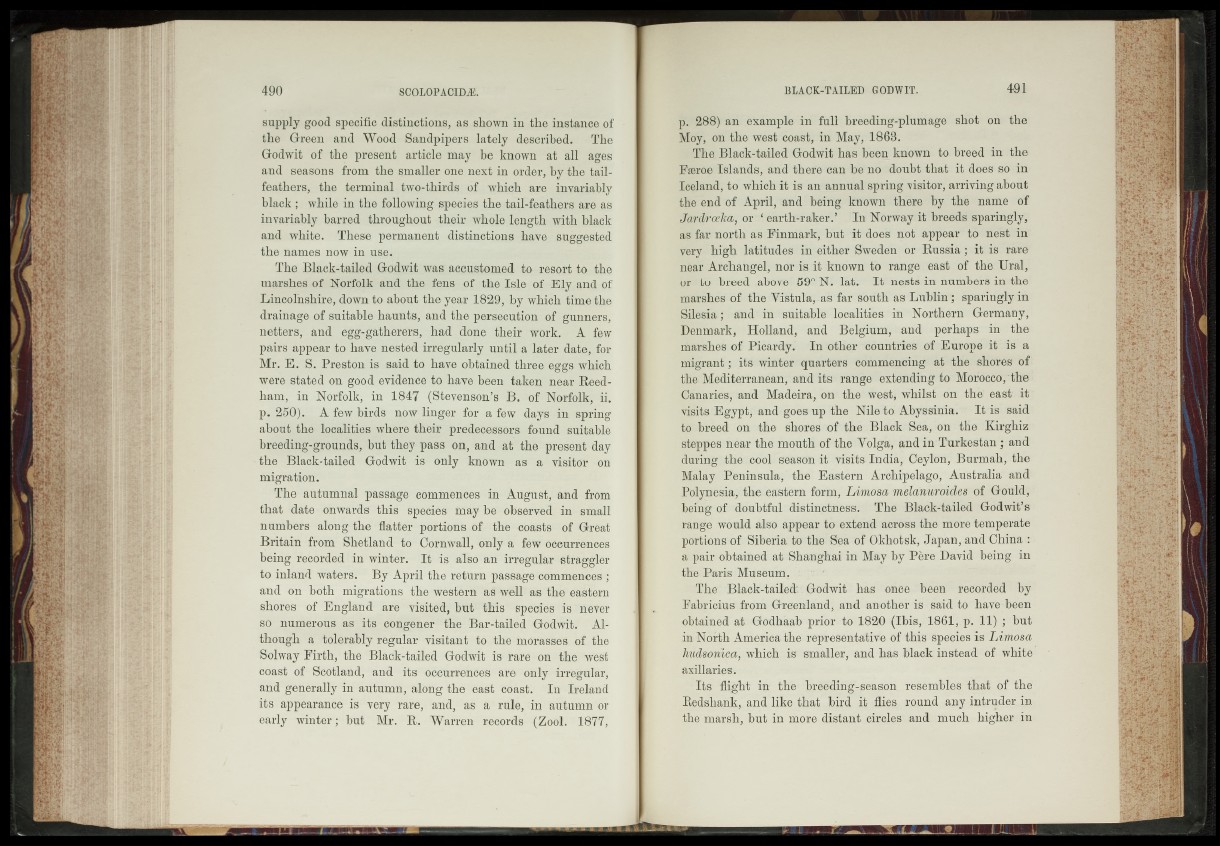
supply good specific distinctions, as shown in the instance of
the Green and Wood Sandpipers .lately described. The
Godwit of the present article may be known at all ages
and seasons from the smaller one next in order, by the tail-
feathers, the terminal two-thirds of which are invariably
bla ck; while in the following species the tail-feathers are as
invariably barred throughout their whole length with black
and white. These permanent distinctions haye0 suggested
the names now in u s e ;; .
The Black-tailed Godwi-t was accustomed to -resort to the
marshes of Norfolk and the fens of the Isle of;-E|y,and of
Lincolnshire, down to about the year 1829;Wy which timjethe
drainage of suitable haunts, and the perseeuttontef gunners,
netterS, and egg-gatherers, had 'dfotre A few
pairs appear to'have hestedhtregularly until a later date,' for
Mr. E . S. Preston.is said t 6 have obtained tjahee, eggs which
were stated on'gdod evidence to have been taken' n ea r Heed-
ham, in Norfolk, in 1847 '(Stevensen’s B. of Norfolkj ii.
p. 250). A few birds now linger, for a few days in -spring
about the localities where their^predeeessors -found suitable
breeding-grounds, but "they pass on, and at the- p’resetft day
the Black-tailed Godwit is only known as a visitor on
migration.
The autumnal passage commences in -August", and from
that date onwards -this species- may be--observed, i-n^ small
numbers along the flatter portions Of -the coasts- -of "Great
Britain from Shetland to:- Corn wall, only a few occurrences
being recorded in winter. I t IP also an 'irregular-ft teggler
to inland waters. By April the retu rn passage commences*;
and on both migrations the western as well as thA eastern
shores of England are visited?,■ b u t' th is ^ p e e fe s -fe '’never
so numerous h s jjb s 1 congener 'th e Bar-tailed:' Godwit.- "Although
a tolerably regular visitant to the-mora-sses of tbe
Solway F ir th /th e Black-taiied-iJG0dwit Is rare o h the west
coast of Scotland, and^lts* occurrences are only irregular,
and generally in1 autumn, along Ihe "%ast "coast. Lh'-ir&land
its appearance' is- very rare,-! arid,'':as a rule, in atifumn-dr
early winte r; but Mr. B. Warren - records: (Zo©l.i|§877,
p. 288) an example iri full bréeding-plumage shot oh the
Moy, on th e west coast, in May,' 1868.
The. Black-tailed Godwit has been known to breed in the-
Fserae Islands, and there* can be no doubt tha t it does so in
Iceland, to which it is an annual spring visitor, arriving about
the end ofc April, and being known 'there 'by the name of
jpfrvdr<xka, o r '| earth-raker.’ In Nórwaytit breeds sparingly,
as f ir north as Finmark, but itedees not' appear to nest in
Wry high latitudes in either SwedenAt •-Russia ; rare
near Archangel; nor is it known to range east .of thé Ural,
or ito breed above' 69-°:N. lat. I t nests.in numbers in the-
marshes of, the 'Vistula^a-'s far south as Lublin1; sparingly in
Silesia; and in suitable localities''in Northern Germany,
Denmark, Holland, and Belgium, and perhaps in the
marshes of Picardy.' In 'o th e r countries, of: Europe it is a
migrant; its winter I quarters commencing at the shores of
the Mediteiranéanf' and its' range ’ extending'f©''Morocco,' the
üïtearies, and Madeira, on* the west; whilst on the“ east it J
visitsSEgypt; .'and g o e s ^ the Nile to. Abyssinia. * It-is. said
to -breed on- ■ the shores of the Black Sea, o n ' the Kirghiz'
sigppes near the mouth of the Wolgft, and in Turkestan'; and
during. tberoeolF season it visits-Iridla^ ÖfèyfOn, Burmah, the
Malay Peninsula, th e ’ Eastern Archipelago," Australia* and
PMyaesia, theJeatefem Lim&sa. melanuroidegi of Gould,
being' of ■ddvbtfal 'distinctness;' The Black-tailed God wit’s
range tvouM fiso appear to extend across the more temperate'
portion s'o f Siberia' to the Seifiof Okhotsk, Japan, andChina :
a.pair. obtained at Shanghai in May by P e te David being un
the Baris.Museum. |
t^The Black-tailed:| .Godwit has óéC;e , ‘“been recorded by
Fabricius from Greenland, .and another igis&iddo-5 have bee-n
obtained a t Godhaab prior to 1820 (Ibis, 1861,.p. 11) ; but
in North America the:.r-epresentat®ve of 'this Spe'eiew ^ IA ym sa
hudmmêaj- which“ 18" smaller, and has black instead' of white
axillaries.
I ts -flight in tWe* brdé'ding-s^ sM ï reiembtésifhat of th £
Redshank,, anddike tn a ^ bird, ^ flip s^ rotund any |n(rijdpr„m
tbe margh, -hut in more distant, circles; and much higher, in